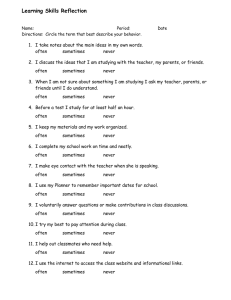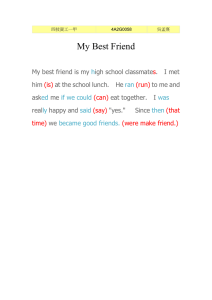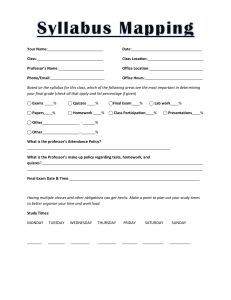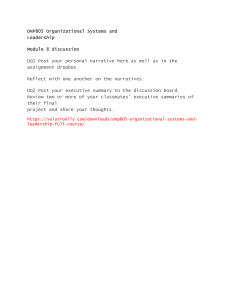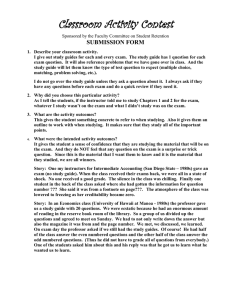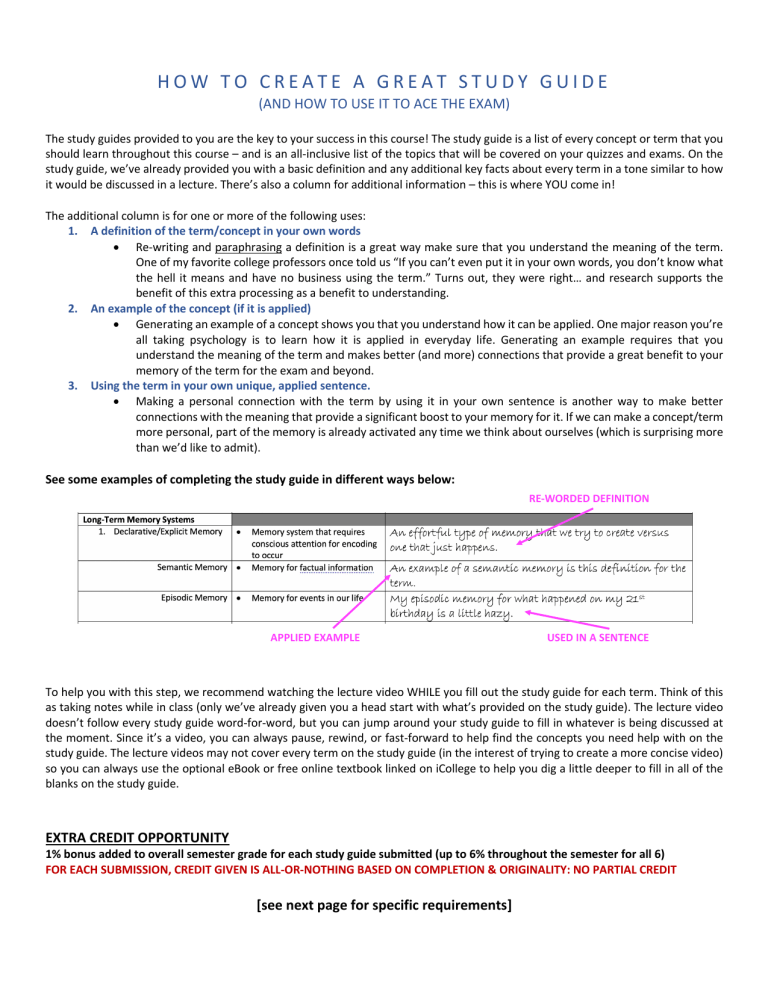
HOW TO CREATE A GREAT STUDY GUIDE (AND HOW TO USE IT TO ACE THE EXAM) The study guides provided to you are the key to your success in this course! The study guide is a list of every concept or term that you should learn throughout this course – and is an all-inclusive list of the topics that will be covered on your quizzes and exams. On the study guide, we’ve already provided you with a basic definition and any additional key facts about every term in a tone similar to how it would be discussed in a lecture. There’s also a column for additional information – this is where YOU come in! The additional column is for one or more of the following uses: 1. A definition of the term/concept in your own words • Re-writing and paraphrasing a definition is a great way make sure that you understand the meaning of the term. One of my favorite college professors once told us “If you can’t even put it in your own words, you don’t know what the hell it means and have no business using the term.” Turns out, they were right… and research supports the benefit of this extra processing as a benefit to understanding. 2. An example of the concept (if it is applied) • Generating an example of a concept shows you that you understand how it can be applied. One major reason you’re all taking psychology is to learn how it is applied in everyday life. Generating an example requires that you understand the meaning of the term and makes better (and more) connections that provide a great benefit to your memory of the term for the exam and beyond. 3. Using the term in your own unique, applied sentence. • Making a personal connection with the term by using it in your own sentence is another way to make better connections with the meaning that provide a significant boost to your memory for it. If we can make a concept/term more personal, part of the memory is already activated any time we think about ourselves (which is surprising more than we’d like to admit). See some examples of completing the study guide in different ways below: RE-WORDED DEFINITION APPLIED EXAMPLE USED IN A SENTENCE To help you with this step, we recommend watching the lecture video WHILE you fill out the study guide for each term. Think of this as taking notes while in class (only we’ve already given you a head start with what’s provided on the study guide). The lecture video doesn’t follow every study guide word-for-word, but you can jump around your study guide to fill in whatever is being discussed at the moment. Since it’s a video, you can always pause, rewind, or fast-forward to help find the concepts you need help with on the study guide. The lecture videos may not cover every term on the study guide (in the interest of trying to create a more concise video) so you can always use the optional eBook or free online textbook linked on iCollege to help you dig a little deeper to fill in all of the blanks on the study guide. EXTRA CREDIT OPPORTUNITY 1% bonus added to overall semester grade for each study guide submitted (up to 6% throughout the semester for all 6) FOR EACH SUBMISSION, CREDIT GIVEN IS ALL-OR-NOTHING BASED ON COMPLETION & ORIGINALITY: NO PARTIAL CREDIT [see next page for specific requirements] FOR EXTRA CREDIT You’d typically be coming to class and taking notes anyway – keeping up with your study guides as suggested above in an onlineequivalent to some of these classroom practices. We are providing this incentive for following some of the best practices in learning and memory throughout the course. In order to receive the extra credit, your study guide: • MUST be filled out completely – you must provide one of the above 3 things in each box (for each term). If any spaces are left blank, you will not receive credit. • MUST be your own work – this is not a group effort and submissions with overlap with your classmates will not be given credit. Crowdsourcing amongst your classmates defeats the purpose of learning from the creation of the study guide entirely, and thus will be awarded nothing. If we find that there is too much Pro-Tip! collaboration amongst peers with this practice, we reserve the right to do away TRY GOING OLD-SCHOOL: with the extra credit opportunity all-together (for everyone). Please don’t ruin PRINT OUT YOUR STUDY GUIDES AND this opportunity for your classmates by trying to take shortcuts that don’t help COMPLETE THEM BY HAND you learn anyway. • MUST be submitted as ONE document to the dropbox folder. You’re welcome to In addition to getting a much-needed break upload the study guide file if you type your notes directly into it. If you’d rather from screen time and an exclusively-digital life, research supports that writing by hand complete your study guide by hand, you can use an app like GeniusScan (free on provides a significant benefit to memory the app store) to take photos of your hand-written study guide and compile it into compared to typing the same material. Part of a single PDF file that can then be uploaded to the dropbox. Do not try to upload the reason for this is that writing by hand 10-15 photos separately, the drop box will only keep the most recent file and you requires more concentration (and attention) than typing. This extra attention increases will not receive credit. both the quality and quantity of cognitive • MUST be submitted by the deadline, each Thursday by 11:59pm. There are no processing and gives you the added boost extensions because late completion will not give you much time to USE the study when it comes to memory! I know, we can all guide to prepare for quizzes (and ultimately the exams). You’re being offered the type faster than we can write, but faster is NOT always better! J extra credit incentive not just for doing the work, but for showing that you’re implementing principles from psychology leading to the best learning and studying practices, which include not only CREATING the study guide, but also leaving yourself time to use it. ONCE YOU’VE FILLED IT OUT, YOU’RE READY TO USE IT TO STUDY Reading over your study guide doesn’t count. Reading is reading… not studying. Studying is the process of testing your ability to remember and practicing your retrieval from memory – TESTING YOURSELF. It’s highly recommended that you print out your study guides to prepare for a quiz or exam. You can do it on screen (or even transfer them over to a quizlet) but you should still follow a similar process. But let’s be honest – we need some time away from that screen! 1. 2. Cover up the definition, so all you see is the concept/term Force yourself to come up with a definition, an example or something else that you can prove to yourself that you fully understand the term. It doesn’t have to be (and really shouldn’t be) perfect word-for-word memorization from the study guide. • DO NOT just say “yeah, I know that one” – you don’t! Prove to yourself that you actually know it by saying the definition out loud. If you can’t do that, you don’t know it! 3. Keep track of what you do and don’t know – mark them with something like a check mark if you do, an “X” if you don’t. Keep testing yourself on the ones you don’t know until you do. • Don’t worry about continuing to test yourself on the terms you already knew the first time – just focus on what you don’t know each round. This should save you time in the long run. Study smarter and harder… not longer. 4. Take breaks, maybe breaking your time into 30-minute sessions. A few hours before you’re ready to take the quiz/exam as a last-minute effort, give yourself one final refresher round of testing. 5. BE CONFIDENT – YOU KNOW YOU KNOW IT NOW!
